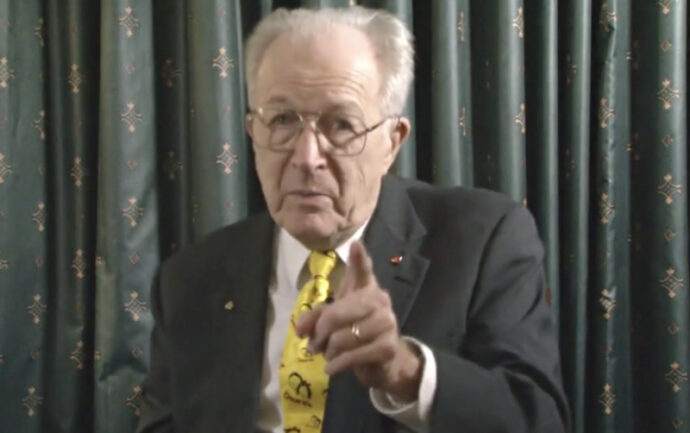John C. “Jack” Willke, an obstetrician who led and shaped the pro-life movement, has died at his home in Finneytown, Ohio. He was 89.
Pro-life advocates praised Willke for providing the cause with scientific facts, and putting those facts in gut-wrenching terms. Critics, on the other hand, have charged that Willke wasn’t as committed to the evidence as he should have been.
Willke and his wife Barbara, who died two years ago, actively opposed abortion even before Roe v. Wade in 1973. Jack Willke wrote an op-ed on abortion for the Cincinnati Enquirer in 1970, and rallied dozens of like-minded people from the area who gathered at a local church and helped the Willkes launch a Right to Life group. It was one of the 300 that existed at the time the court ruled the US Constitution protects the right to privacy and that privacy extends to a women’s decision to have an abortion.
Before they became anti-abortion activists, Jack and Barbara Willkes worked together as sex educators. Catholics and medical professionals—Barbara was a registered nurse and Jack a practicing obstetrician—they co-taught a pre-marital course at their church. “The couple developed a style that would serve them for years to come,” the Cincinnati Enquirer reports. “They shared the microphone, with each one talking for a couple of minutes, then the other, throughout the presentation.” The couple wrote a book on sex ed that was very popular among Catholic educators, and they travelled together, lecturing on the topic.
As Barbara recalled, the Willkes were happy as sex educators, and only got involved in the issue of abortion when their daughters and some of their daughters’ friends began asking questions. They found there was a lack of medically credible pro-life information. They felt they needed to explain to people what abortion really was.
For his part, Willke described his radicalization as an accident of circumstances as much as anything. “Each little piece happens,” he said in 2013. “I was perfectly content to be a family physician and deliver a lot of babies … but this one happened and that one happened.”
The turning point, he said, was when, at a marriage counsellors retreat in California, a Catholic priest asked him “What are you guys doing on abortion?” Willke realized the answer was, “not enough.”
When the Willkes did get involved, they committed completely. Willke stopped delivering babies to focus on opposition to abortion and eventually closed his practice in 1988, the 40th anniversary of his practice and his marriage.
“My husband said if we got involved it would swallow us up, and I guess it did,” Barbara later said.
The couple co-authored a foundational text of the pro-life movement, Handbook on Abortion in 1971.
It was self-published, originally. According to legal scholar Linda Greenhouse, it had significant impact. “It got distributed like wildfire,” Greenhouse said. “It really became a Bible of the right-to-life moment.” More than 1.5 million copies were sold “at the height of the sexual revolution,” according to the Associated Press, and it has been reprinted in 20 different languages since.
It was a short book, running 151 pages in some editions, with 42 citations of scientific papers and a section of graphic photos of aborted fetuses. It was part medical text and all polemic, arguing that abortion was a great moral tragedy and a pressing civil rights issue.
Throughout his career, Willke argued against abortion with gruesome descriptions of the process. In an interview in 2000, for example, he described the extremely rare procedure of intact dilation and extraction (IDX), which pro-life advocates call “partial-birth abortion.” Willke’s account alternated between medical details and the physical reactions of the fetus.
“This baby,” he said, “is kicking, moving its arms and has likely urinated.”
That polemical approach led Willke into controversial territory. His commitment to the cause of the unborn was so strong, so all-consuming, critics warned, that he would put out misinformation if it would help.
“He’s always been very sincere,” said Al Gerhadstein, a Cincinnati attorney and abortion-rights proponent who occasionally debated Willke. “And I’ve always been wary that he doesn’t let the facts get in the way.”
Wilke’s pro-life education efforts became the subject of some scrutiny in 2012, when a Republican candidate for the Senate used what he had learned from Willke to explain why he would ban abortion without exception. Six-term Missouri Congressman Todd Akin, running as a Tea Party candidate, said he didn’t support allowing abortion in cases of rape, because “If it’s a legitimate rape, the female body has ways to try to shut that whole thing down.” That information—widely dismissed by experts as “nuts,” “nonsense” and “absurd”—was traced back to Willke.
At least as early as 1985, Willke was claiming that the traumatic nature of rape made women very unlikely to conceive. In a 1999 article, he wrote for Life Issues Connector:
There’s no greater emotional trauma that can be experienced by a woman than an assault rape. This can radically upset her possibility of ovulation, fertilization, implantation and even nurturing of a pregnancy. So what further percentage reduction in pregnancy will this cause? No one knows, but this factor certainly cuts this last figure by at least 50 percent and probably more …. So assault rape pregnancy is extremely rare.
Willke estimated that maybe 500 women got pregnant this way every year. The evidence he cites in the article is thin, at best. An article published in the American Journal of Obstetrics & Gynecology in 1996, on the other hand, found that about 5 percent of rapes result in pregnancies, and there are more than 32,000 pregnancies resulting from rapes annually.
Willke nevertheless stood by his claims, telling the New York Times the real number was “way under 1 percent.” In part, the claim was justified by distinguishing between types of rape, which was exactly the thing that upset people so much about Akin’s statement.
Willke’s rhetoric could also exhibit some of the more hysterical tendencies of the pro-life movement. In one letter to supporters, for example, he alleged that abortionists were harvesting and selling organs from fetuses. The information was based on an anecdote from one anonymous source, but Willke relayed it as verified truth.
“These are real baby parts,” he wrote, “often from live born babies who have been delivered by Partial-Birth abortion … Now we know why the abortion industry has a vested interest in keeping partial birth abortions legal. They need this grisly procedure so they can get intact bodies in order to harvest and sell the body parts of babies they kill.”
He hoped the horror of late-term abortions would spark moral outrage in those who would rather not think about the details of abortion.
Willke said this tactic had worked with the political issue of slavery in 1850s Ohio when the Fugitive Slave Act, which allowed slavers to re-capture escaped slaves in the North and then march them back to slavery, brought the horror of the practice into plain sight, and shocked many who had been content not knowing about it before.
“This rubbed it in the faces of good people,” Willke said. “Not long after that, the whole thing exploded.”
Those who were moved to activism by Willke remembered not his exaggerations or questions of evidence, but the graphic presentation of what abortions are actually like. Willke was renowned for slide shows, in the early years, showing students and church groups pictures and diagrams of fetal development, followed by pictures and diagrams of abortion.
Chuck Donovan, a pro-life activist who heard the Willkes speak when he was a student at Notre Dame in 1972, recalled how powerful that approach was:
They pulled back the veil of rhetoric covering the brutal reality of ‘abortion rights.’ With full awareness of the passions the images they brought might evoke, they debunked the language of abortion advocates regarding the ‘products of conception’ or ‘uterine contents.’ They were medical experts speaking to a university audience at risk of being deluded about the reality of fetal development. This was not graphic signage in a public march (where it remains, I believe, inappropriate to this day) but a briefing about a core, contested issue: Is the unborn child one of us? Human? Our brother or sister?
Jack Willke joined the board of National Right to Life in 1973 and served on it until his retirement in 2012. He was president of that organization from 1980 to 1991. He and his wife co-authored a total of 12 books and Willke also did a daily radio show, called Life Issues, which was heard on several hundred stations, nationwide, and a series of one-minute radio spots, called Life Jewels, which were heard broadcast world-wide.
He led the movement and also shaped it, giving pro-life advocates the language they used, sometimes successfully and sometimes less so.
He is survived by six children, 22 grandchildren and three great-grandchildren. A funeral mass was said at 11 a.m. on Feb. 26 at St. Clare’s Church in Cincinnati.





